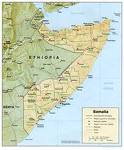
Somali is the official language of the Somali Republic, and it is spoken in Sudan, Ethiopia, Eritrea, Uganda, Kenya and Djibouti as well. It is also spoken in Canada, the US, the UK, Finland, Sweden, and the Netherlands…
In the United States, Somalis are mainly concentrated in Minneapolis, Columbus, Nashville and Atlanta.
Throughout history, this language has used four different writing systems: an Arabic one known as the Wadaad writing, Latin, and two other native writing scripts: the Osmanya and the Borama.
Some characteristics of the Somali language are:
• It is written from left to right, horizontally.
• The letters are based on Arabic letters.
• It is a tonal language. It has four tones, which cannot be expressed graphically. The tones are not interpreted as in Chinese, where each tone represents a different term. In the Somali language tones do not mean different concepts, but they do have an important grammatical significance: they indicate gender and number.
Some comparisons with some Western languages:
• Somali uses all the letters of the alphabet, except for these four: p, v, y and z.
• Many sounds are very similar to the sounds we know in the Western world: b, d, f, g, h, j, k, l, m, n, s, sh, t, w, y.
• It has its own consonants: c, dh, kh, q, r, x [glottal stop].
• In Somalia, there are double consonants to indicate a much stronger sound than the same sound with only one consonant. These consonants are: b, d, dh, g, l, m, n, r. This peculiarity explains why many Somalis pronounce these English words with double consonants with greater emphasis than a word with only one consonant: bigger, middle, merry, simmer, nibble.
• Something similar happens with the double vowels, whose sound is longer than the simple vowels: aa, ee, ii, oo and uu.
Articles
Articles in Somali are more like the articles in Spanish or French. They distinguish between feminine and masculine.
Additionally, just like in these Romance languages, it is more complex to translate the English indefinite article (a/an) precisely because there is no such a concept in Somali. In Somali, an indefinite concept is expressed with the noun alone.
As mentioned before, the tone is what denotes gender and number.
Adjectives
In Somali, adjectives are formed by adding “an” or “san” to a verb or a noun.
Verbs
Unlike Western languages, verbs in Somali are placed at the end of the sentence. For this same reason, Somalis tend to put the verb at the end of the sentence in English, as they do in their native language. In Somali there is no passive voice, which is very common in English.
While Somali has a “simple present” and a “present continuous” verb tense as in English, they are used in differently. For example, a Somali would use the “present continuous” when an English speaker would use the “simple present”.
Proverbs
Some highlights … Somalis boast about their rich tradition of proverbs that pass on from generation to generation. Proverbs are a living part of their culture and they play an important role in their daily lives. This explains the misuse of pronouns when they write or speak English.
All these characteristics of the Somali language bring us a bit closer to this culture and also help us see the importance of really knowing a language in order to properly translate it.
For further inquiries about Afro-Asiatic languages, please contact us at: www.trustedtranslations.com
(Versión en español: https://www.trustedtranslations.com/somali-lengua-afroasiatica-2011-07-06.html)





